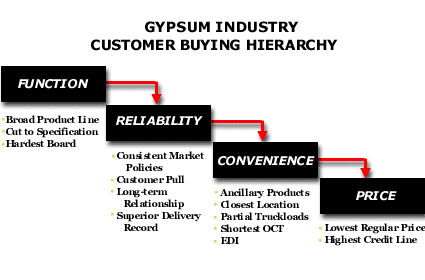Analysis 44: Customer Buying Hierarchy Definitions
EXHIBITS:

HOW TO INTERPRET THE ANALYSIS: This Analysis shows a particular industry's meaning of the categories in the Customer Buying Hierarchy: Function, Reliability, Convenience and Price. The definitions, or product benefits, shown here are those that tend to be either unique or, at least, limited to a few competitors in the marketplace. Under Function there are three defining benefits. The first is a broad product line, meaning the company offers various types of related products. The second benefit under Function is that the product is cut to the customer's specifications, so the customer gets a customized product. The final benefit under Function is hardest board.
PURPOSE: This analysis should highlight those benefits and price approaches that enable competitors in the marketplace to be unique. The analysis places every unique benefit into the customer buying hierarchy. When used over time, the hierarchy helps the company understand benefits that have a long period of uniqueness. APPROACH: Customers buy in a consistent order: (1) First, they want Function. Does the product do what they want it to do? Oftentimes, anything that can be built into the product itself can be considered a Function. (2) Next, the customer buys Reliability. Reliability means that the product works and that the company will stand behind the product. This description of Reliability applies to a Final customer. Reliability for a channel of distribution, an Intermediary customer, means that the company delivers what, when and where it said it would and that it maintains a consistent approach to the marketplace and to the channel of distribution. (3) Convenience is next. Convenience is another way of saying short order cycle time (OCT). A company can become more convenient by offering ancillary products, so the customer has the opportunity for one-stop shopping, or by providing more locations for purchases, and so forth. (4) Price means some form of the lowest price in the marketplace, either a low delivered price or a larger credit line than is average in the industry. The company develops these definitions of benefits on the hierarchy by evaluating why customers change suppliers and asking what the gaining competitor offered that no one else offered to that customer. The company obtains this information either through debriefing the sales force or by interviewing customers. Return to Diagnose Products and Services: Customer Buying Hierarchy |
|
Recommended Reading |
| For a greater overall perspective on this subject, we recommend the following related items:
Analyses: Symptoms and Implications: Symptoms developing in the market that would suggest the need for this analysis.
Perspectives: Conclusions we have reached as a result of our long-term study and observations.
|
